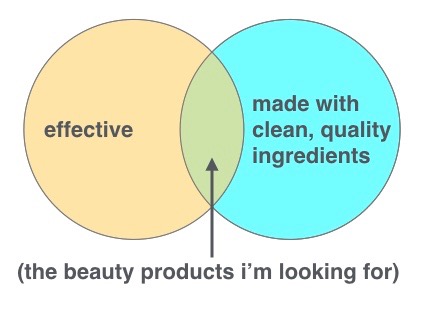Finding and sharing fabulous beauty products is a great joy in my life. I share products and services I have tested and believe in.
Coverage is never in exchange for payment or other incentives.
The Anatomy of a Great Product
My goal is to find beauty products which are both effective and clean.

I care less about what a product isn’t, and more about what it is.
I believe that, at a minimum, cosmetics should never undermine wellness. Ideally, they should support the health and vitality of the person using them.
The Variability of Personal Standards
I realize that for some, my standards are too high. Paranoid, even. And for others, I’m haphazard with my own health.
But I believe that everyone should make their own informed decisions about which products to put on or in their body.
My own standards vary. If I’m pregnant or breastfeeding, I’ll be extremely selective about which beauty products I’ll use, but if I’m merely glamming it up for a big event, I’ll opt for the lipstick and foundation that give me the best results for the evening, organic or not. Some women may feel comfortable using “red” ingredients while pregnant. If their midwife or OB is on board with that, it’s fine.
I believe that everyone should be able to understand what’s in their favorite beauty products, and be able to use (or not use) accordingly.
The Ingredient Key
Ingredients are shown in four colors: green, yellow, red, or gray. The Ingredient Key will help you determine the overall safety and quality of the individual ingredients in any given product.
| Extremely Safe | Reasonably Safe | Proceed with Caution | Insufficient Data |
My assessment of individual ingredients is carefully done via reputable and thorough resources, with consideration given to the type of product being assessed (loose powder vs. cream, for instance). There is sometimes no consensus on the safety of a particular ingredient; in such cases I attempt to weigh the validity of all points of view, although I tend to err on the side of caution.
One of the biggest problems I run into while researching products are ingredients without sufficient data to verify safety. This happens surprisingly often. I approach beauty products with these ingredients cautiously. I’d hate for the first independent research on a mystery ingredient to raise concerns of carcinogenicity or endocrine disruption.
Keep it Simple
Latin or other lengthy technical names aren’t usually included if a more simple term exists. I do this for brevity’s sake. Jojoba oil means so much more to me, as a consumer, than does simmondsia chinensis.
Natural vs. Synthetic Ingredients
My first love are products made of organic and wild-harvested plant-based ingredients.
But not all of the beauty products I use are completely free of synthetics. Some synthetics, like iron oxides and polybutene, have well-established safety records and can be found in high-quality clean cosmetics.
For someone with a deep love of all things natural, this was a hard pill to swallow. But I’ve learned that not all natural ingredients are safe, and not all synthetics are bad.
Testing the Products
I do not work for any beauty brand, and I’m not pushing any agenda other than my own awareness as a consumer.
Products are assessed according to two standards: effectiveness and safety. I also take into consideration the quality and manufacturing of products, if such information is available.
A mascara, for instance, is first considered for its ability to do its job; it should make my lashes darker and longer, with minimal smudging throughout the day. Second, the safety and quality of the ingredients in that mascara are evaluated, one by one.
I generally test a product for 3-4 weeks before sharing it here on The Beauty Proof. Some makeup may be tested for a shorter time period.
Affiliate Links
Learn more about affiliate links on this website here.
What’s Up With The Old Books?
I photograph natural beauty products alongside old books.
Weird, right?
At The Beauty Proof, I treat you the way I want to be treated. And that means maintaining integrity in my reviewing process. I only profile products I’ve personally handled and tested. The photography is done in its unique way, partly so you can see what the products look like, but also so you can feel confident that I have firsthand knowledge of what I’m sharing with you.
Why books instead of, say, pineapples? I have a lot of beautiful old books laying around. I collect them, so they’re handy.
Haven’t you ever wondered if the new serum or mascara being flaunted in a magazine or blog was actually tested by the person writing about it?
In today’s world of sponsored content and clickbait, it’s hard to gauge trustworthiness. Besides, none of us want to fall victim to copy-and-paste shenanigans.
This isn’t just about what you see here on The Beauty Proof. Whatever you’re researching online, ask yourself, How trustworthy is this opinion? What incentive does this writer have to push me towards this product, idea, or action? Because intentions matter.
You’re looking for a clean beauty routine. And I’ve found amazing products and resources to share with you.
So when you see this odd combination of old books and cosmetics, feel confident in the quality of the recommendation.
Go ahead. Find the makeup and skincare that work for you.
